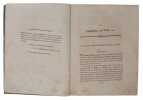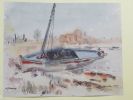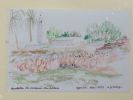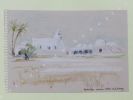481 books for « davy m m »Edit
-
Type
Book (463)
Drawings (9)
Magazine (5)
Music sheets (4)
-
Latest
Last month (14)
Last week (1)
-
Language
English (1)
French (477)
German (2)
Russian (1)
-
Century
17th (5)
18th (16)
19th (63)
20th (180)
21st (31)
-
Countries
Belgium (40)
Denmark (44)
France (375)
Italy (2)
Switzerland (19)
United States of America (1)
-
Syndicate
ILAB (183)
SLAM (138)
SNCAO (2)
Topics
- Age (3)
- Agriculture (6)
- Ampere andré - marie (3)
- Archaeology (4)
- Architecture (29)
- Atlantis (2)
- Belgium (4)
- Biography (5)
- Botany (3)
- Bouniol (2)
- Brittany (4)
- Chemistry (38)
- Children’s books (7)
- Christianity (3)
- Cinema (3)
- Comic strip (3)
- Computer science (2)
- Constantinople (13)
- Davy marie-madeleine (26)
- Dedication (2)
- Discovery (8)
- Drawings (3)
- Durkheim emile (4)
- Earth (3)
- England (2)
- Esotericism (7)
- Essays (5)
- Ethic (5)
- Fine arts (3)
- First edition (4)
- Flammarion camille (4)
- Flora (3)
- Gay lussac (5)
- Genealogy (2)
- Geography (3)
- Geology (3)
- Greece (2)
- Hermeticism (4)
- History (25)
- Hydrogen (3)
- Industrial arts & crafts - fine arts (4)
- Islam muslim (2)
- Jacob (2)
- Judaism (judaica) (2)
- Languedoc (2)
- Literature (28)
- Medicine (3)
- Mediterranean sea (3)
- Metaphysics (2)
- Meteorology (5)
- Middle ages (4)
- Morphology (3)
- Navy (3)
- New-york (2)
- Normandy (6)
- Painters (34)
- Palaeontology (2)
- Palaeozoology (2)
- Paris (41)
- Philosophy (47)
- Physics (5)
- Psychology (12)
- Regionalism (3)
- Religions (19)
- Review (9)
- Reviews (5)
- Revolution 1789 (3)
- Sciences (14)
- Sciences & technique (4)
- Scores (6)
- Sculpture (5)
- Sociology (8)
- Songs (4)
- Symbolism (6)
- Tea (17)
- Theology (5)
- Travel (30)
- Tunisia (4)
- Turkey - ottoman empire (16)
- United kingdom (2)
- United states (3)
- Various (2)
- Water-colour (24)
DAVY, HUMPHRY. - FOUNDATION OF ELECTRO-CHEMISTRY - FIRST GERMAN EDITION.
Reference : 44098
(1809)
Ueber einige neue Erscheinungen chemischer Veränderungen, welche durch die Elektricität bewirkt werden" insbesondere über die Zersetzung der feuerbeständigen Alkalien, die Darstellung der neuen Körper, welche ihre Basen ausmachen, un die Natur der Alk...
(Halle, Rengerschen Buchhandlung, 1809). Without wrappers. In ""Annalen der Physik. Herausgegeben von Ludwig Wilhelm Gilbert"", Bd. 31, Zweites Stück. Pp. 113-224 a. 1 engraved plate.(The entire issue offered). Davy's paper: pp. 113-177.
First German edition of this landmark paper in chemistry, in which Davy shows that electricity is capable of decomposing the most stable chemical combinations. He decomposes some alkalies, isolating two new substances and discovering potassium and sodium. Neville in his Historical Chemical Library vol. I, p.340, writes about this paper ""ONE OF THE GREAT CLASSIC RESEARCHES IN CHEMISTRY, in which Davy announced in this, his second Bakterian lecture, the isloation of metallic potassium and sodium by the electrolytic decomposition of their fused oxides.""""He (Davy) began his own electrical experiments...The results were spectacular. On October 6, 1807, the current passing through molten potash liberated a metal, which Davy called potassium. The little globules of shining metal tore the water molecule apart as it eagerly recombined with oxygen and the liberated hydrogen burst into lavender flame. Davy danced about in a delirium of joy. A week later he isolated sodium from soda.""(Asimow). The paper offered here describes these discoveries.""Humphry Davy was one of the most brilliant chemists of the early nineteenth century. His early study of nitrous oxide brought him his first reputation, but his later and most importent investigations were devoted to electrochemistry. Following Galvani's experiments and the discovery of the voltaic pile, interest in galvanic electricity had become widespread. The first electrolysis by means of the pile was carried out in 1800 by Nicholson and Carisle, who obtained oxygen and hydrogen from water. Davy began to examine the chemical effects of electricity in 1800, and his numerous discoveries were presented in his Bakerian lecture to the Royal Society on November 20, 1806.(A Source Book in Chemistry p. 243). - Wheeler Gift: 2514.
"DAVY, HUMPHRY - THE DISCOVERY OF HYDROGEN TELLURIDE - THE RIVALRY WITH GAY-LUSSAC & THENARD.
Reference : 46377
(1810)
Nouvelles Recherches électro-chimiques, principalement relatives aux substances métalliques tirées des alcalis et de terres, et à quelques combinations de l'Hydrogène. (+) Suite des Recherches... (+) Sur les Observations sur les Recherches faites p...
Paris, J. Klostermann, 1810. Contemp. hcalf. Spine gilt. Slightly rubbed. A few scratches to binding. Small stamps on verso of titlepage.In: ""Annales de Chimie, ou Recueil de Mémoires concernant la Chemie"" Tome 75. 336 pp. a. 2 folded engraved plates. Some scattered brownspots. The papers: pp. 27-77, 129-175, 256-263, 264-273, 274-289 a. 290-316.
First French version of Davy's ""The Bakerian Lecture for 1809. On some new Electrochemical Researches, on various Objects, particularly the metallic Bodies, from the Alkalies, and Earth, and on some Combinations of Hydrogene. Read November 16, 1809."", together with the controversy papers by Davy and Gay-Lussac & Thenard.""Mr. Davy having from the commencement of his electro-chemical researches, communicated the several steps of his progress to the Society (The Royal Society), takes the present opportunity of reporting the results of his further inquiries under four principal heads. First, on the nature of the metals of the fixed alkalis. Second, on the nature of Hydrogen and composition of ammonia. Thirdly, on the metals of the earth"" and Fourthly he makes a comparison between the antiphlogistic doctrine, and a modified phlogistic hypothesis.""(Abstract). He further gives arguments for considering potassium and sodium, which he discovered in 1808, as a element.""""Gay-Lussac had a slight rivalry between himself and the creation scientist Sir Humphry Davy. Davy was chemically preparing Potassium and Sodium through an electrical current, and this made Gay-Lussac and Thénard envious of his success. They too decided to perform the same task, but they had no battery at their disposal as Davy had, so they had to form another way to chemically prepare the two elements. In 1808, they used a red-hot iron fused to potash, the water-soluble form of a manufactured salt containing potassium, to perform this task, a method that Davy admitted had its advantageous qualities. Gay-Lussac and Thénard were successful in preparing Potassium, and continued to make a full analysis of its chemical properties, and began to use it for their own experiments. In 1809, Davy performed the same task, using it to reduce Boron in Boracic acid.""
"DAVY, HUMPHRY - THE DISCOVERY OF POTASSIUM AND SODIUM (FRENCH VERSION).
Reference : 50198
(1809)
Recherches ëlectrochimiques sur la décomposition des terres, avec des observations sur les métaux obtenus des terres alcalines, et sur un amalgame produit avec l'ammoniaque. Tireeis des Transactions philosophiques, et traduites par M. C.A. Prieur. (+)...
Paris, Mad. Ve Barnard, 1809. Contemp. hcalf. Spine gilt. Wear to top of spine. A few scratches to binding. Small stamps on verso of titlepage.In: ""Annales de Chimie, ou Recueil de Mémoires concernant la Chemie"" Tome 70. 336 pp. (Entire volume offered). Davy's paper: pp. 189-254.
First edition in French (the first English 1808) of this importent historical paper in chemistry, in which Davy shows that electricity is capable of decomposing some alkalies, isolating two new substances and discovering potassium and sodium. Neville in his Historical Chemical Library vol. I, p.340, writes about this paper ""ONE OF THE GREAT CLASSIC RESEARCHES IN CHEMISTRY, in which Davy announced in this, his second Bakterian lecture, the isloation of metallic potassium and sodium by the electrolytic decomposition of their fused oxides.""""He (Davy) began his own electrical experiments...The results were spectacular. On October 6, 1807, the current passing through molten potash liberated a metal, which Davy called potassium. The little globules of shining metal tore the water molecule apart as it eagerly recombined with oxygen and the liberated hydrogen burst into lavender flame. Davy danced about in a delirium of joy. A week later he isolated sodium from soda.""(Asimow). The paper offered here describes these discoveries.""Humphry Davy was one of the most brilliant chemists of the early nineteenth century. His early study of nitrous oxide brought him his first reputation, but his later and most importent investigations were devoted to electrochemistry. Following Galvani's experiments and the discovery of the voltaic pile, interest in galvanic electricity had become widespread. The first electrolysis by means of the pile was carried out in 1800 by Nicholson and Carisle, who obtained oxygen and hydrogen from water. Davy began to examine the chemical effects of electricity in 1800, and his numerous discoveries were presented in his Bakerian lecture to the Royal Society on November 20, 1806. (A Source Book in Chemistry p. 243).
"DAVY, HUMPHRY. - THE DISCOVERY OF THE ANAESTETHIC EFFECTS OF ""LAUGHING GAS""
Reference : 44095
(1799)
Athembarkeit des sauerstoffhaltigen Stickgas"" aus einem Briefe H.Davy's an Will. Nicholson. (+) Nachricht von einigen merkwürdigen Versuchen Davy's. (Aus einem Briefe Humphry Davy's an Will. Nicholson).
Halle, Rengerschen Buchhandlung, 1799, 1800. Without wrappers extracted from ""Annalen der Physik. Herausgegeben von Ludwig Wilhelm Gilbert"", Bd. 2. p. 483 (one page). and Bd. 6, pp. 105-115. Some scattered brownspots.
First German translation of Davy's announcement (the announcement on 1 page) of his discovery of the unusual, anaesthetic, effects of nitrous oxide which, on being inhaled, gave rise to a giddy, intoxicated feeling. On announcing his discovery he says, that he will publish a paper discribing the experiments with the gas, later. This is the paper offered here, also in the first German version. Both the announcement and the paper were issued in the ""Annalen"" the same year as they appeared in Nicholson's Journal.The gas was first synthesized by English natural philosopher and chemist Joseph Priestley in 1772, who called it phlogisticated nitrous air.""Following Priestley's discovery, Humphry Davy of the Pneumatic Institute in Bristol, England, experimented with the physiological properties of the gas, such as its effects upon respiration. He even administered the gas to visitors to the institute, and after watching the amusing effects on people who inhaled it, coined the term 'laughing gas'! Davy even noted the anaesthetic effects of the gas: ""As nitrous oxide in its extensive operation appears capable of destroying physical pain, it may probably be used with advantage during surgical operations in which no great effusion of blood takes place"".(Wikipedia).""Davy discovered the anaesthetic properties of nitrous oxide and suggested its use during surgiical operations, a suggestion which was not turned to useful account until 1844.""(Garrison & Morton, 5646, not mentioning the announcing of its discovery in 1799).
The Bakerian Lecture, on some new Phenomena of chemical Changes produced by Electricity,particularly the Decomposition of the fixed Alkalies, and the Exhibition of the new substances which constitute their bases" and on the general Nature of alkaline ...
(London, W. Bulmer and Co., 1808). 4to. No wrappers as extracted from ""Philosophical Transactions"" 1808 - Part I. Pp. 1-44.
First printing of this importent historical paper in chemistry, in which Davy shows that electricity is capable of decomposing some alkalies, isolating two new substances and discovering potassium and sodium. Neville in his Historical Chemical Library vol. I, p.340, writes about this paper ""ONE OF THE GREAT CLASSIC RESEARCHES IN CHEMISTRY, in which Davy announced in this, his second Bakterian lecture, the isloation of metallic potassium and sodium by the electrolytic decomposition of their fused oxides.""""He (Davy) began his own electrical experiments...The results were spectacular. On October 6, 1807, the current passing through molten potash liberated a metal, which Davy called potassium. The little globules of shining metal tore the water molecule apart as it eagerly recombined with oxygen and the liberated hydrogen burst into lavender flame. Davy danced about in a delirium of joy. A week later he isolated sodium from soda.""(Asimow). The paper offered here describes these discoveries.""Humphry Davy was one of the most brilliant chemists of the early nineteenth century. His early study of nitrous oxide brought him his first reputation, but his later and most importent investigations were devoted to electrochemistry. Following Galvani's experiments and the discovery of the voltaic pile, interest in galvanic electricity had become widespread. The first electrolysis by means of the pile was carried out in 1800 by Nicholson and Carisle, who obtained oxygen and hydrogen from water. Davy began to examine the chemical effects of electricity in 1800, and his numerous discoveries were presented in his Bakerian lecture to the Royal Society on November 20, 1806.(A Source Book in Chemistry p. 243). - Wheeler Gift: 2514.
The Bakerian Lecture, on some new Phenomena of chemical Changes produced by Electricity,particularly the Decomposition of the fixed Alkalies, and the Exhibition of the new substances which constitute their bases" and on the general Nature of alkaline ...
(London, W. Bulmer and Co., 1808). 4to. No wrappers as extracted from ""Philosophical Transactions"" 1808 - Part I. Pp. 1-44. Clean and fine, wide-margined.
First printing of this importent historical paper in chemistry, in which Davy shows that electricity is capable of decomposing some alkalies, isolating two new substances and discovering potassium and sodium. Neville in his Historical Chemical Library vol. I, p.340, writes about this paper ""ONE OF THE GREAT CLASSIC RESEARCHES IN CHEMISTRY, in which Davy announced in this, his second Bakterian lecture, the isloation of metallic potassium and sodium by the electrolytic decomposition of their fused oxides.""""He (Davy) began his own electrical experiments...The results were spectacular. On October 6, 1807, the current passing through molten potash liberated a metal, which Davy called potassium. The little globules of shining metal tore the water molecule apart as it eagerly recombined with oxygen and the liberated hydrogen burst into lavender flame. Davy danced about in a delirium of joy. A week later he isolated sodium from soda.""(Asimow). The paper offered here describes these discoveries.""Humphry Davy was one of the most brilliant chemists of the early nineteenth century. His early study of nitrous oxide brought him his first reputation, but his later and most importent investigations were devoted to electrochemistry. Following Galvani's experiments and the discovery of the voltaic pile, interest in galvanic electricity had become widespread. The first electrolysis by means of the pile was carried out in 1800 by Nicholson and Carisle, who obtained oxygen and hydrogen from water. Davy began to examine the chemical effects of electricity in 1800, and his numerous discoveries were presented in his Bakerian lecture to the Royal Society on November 20, 1806.(A Source Book in Chemistry p. 243). - Wheeler Gift: 2514.
GAY-LUSSAC ; ARAGO ; DAVY ; BAUMGARTNER ; BERTHIER ; COLLADON ; BREWSTER ; DUMAS ; Collectif
Reference : 20373
(1826)
Annales de Chimie et de Physique. 1826 -Tome XXXIII - Volume 3 : Tome Trente-Troisieme [ Tome 33 ] : Sur les relations qui existent entre les actions electriques et les actions chimiques (Davy) - Sur l'aimantation de l'acier par la lumiere blanche directe du soleil (Baumgartner) ; Sur la Preparation du Nickel (Berthier) ; Deviation de l'Aiguille aimantee par le courant d'une machine electrique ordinaire, et par l'electricite des nuages (Colladon) ; De la Temperature des differentes parties de la zone torride au niveau des mers (Humboldt) ; Experiences electro-metriques du Dr. Stefano Marianini, proefesseur de physique et de mathematiques appliquees au Lycee de Venise ; Sur le Brome (Liebig) ; Sur les pouvoirs refringens de deux nouveaux fluides contenus dans les cavites de certains mineraux (Brewster) ; Memoire sur quelques points de la theorie atomistique (Dumas) ; etc...
1826 Chez Crochard, Paris, 1826,exemplaire en livraisons mensuelles 4 fascicules : septembre,octobre,novembre,decembre 1826 - IN8 br.- couvertures conservées -cachet bib.-non rognées: pagination continue , 448 pp.- sans la planche dépliante non annonçée (p.337-392 pour l'article de Dumas).
Contient notamment : Sur les relations qui existent entre les actions electriques et les actions chimiques (Davy) - Sur l'aimantation de l'acier par la lumiere blanche directe du soleil (Baumgartner) ; Sur la Preparation du Nickel (Berthier) ; Deviation de l'Aiguille aimantee par le courant d'une machine electrique ordinaire, et par l'electricite des nuages (Colladon) ; De la Temperature des differentes parties de la zone torride au niveau des mers (Humboldt) ; Experiences electro-metriques du Dr. Stefano Marianini, proefesseur de physique et de mathematiques appliquees au Lycee de Venise ; Sur le Brome (Liebig) ; Sur les pouvoirs refringens de deux nouveaux fluides contenus dans les cavites de certains mineraux (Brewster) ; Memoire sur quelques points de la theorie atomistique (Dumas) ; etc...Contient des ouvres de Humboldt, Colladon, Brewster, Liebig et Davy. Remise de 20% pour toutes commandes supérieures à 200 €
[Crochard] - ARAGO ; BERTHOLLET ; VAUQUELIN ; HUMPHRY DAVY ; FRESNEL, Augustin ; AMPERE ; GAY-LUSSAC ; HUMBOLDT ; VIREY ; HAUY ; DALTON
Reference : 34613
(1816)
Annales de Chimie et de Physique. Année 1816 - Volume I - Tome Premier [ Tome 1 ] : Sur les Puissances réfractives et dispersives de certains liquides et des vapeurs qu'ils forment (Arago et Petit) ; Note sur le Principe colorant du sang des Animaux (Vauquelin) ; Expériences sur la combustion du Diamant et d'autres substances carbonacées (Humphry Davy) ; Observations sur l'oxidation de quelques métaux (Gay-Lussac) ; Relation de la chute d'une pierre météorique tombée dans les environs de Langres (Virey) ; Sur la hauteur relative des Niveaux de la mer Noire et de la mer Caspienne (Maurice d'Engelhardt et François Parrot) ; Tables des dilatations linéaires qu'éprouvent différentes substances depuis le terme de la congélation de l'eau jusqu'à celui de son ébullition d'après les expériences de MM. de Laplace, Lavoisier, Smeaton, Roy ; Description d'un nouveau Baromètre portatif (Gay-Lussac) ; Mémoire sur l'air inflammable des mines de charbon (Humphry Davy) ; Observations sur l'influence que le vent apporte dans la propagation du son (Delaroche) ; Note sur un phénomène remarquable qui s'observe dans la diffraction de la lumière (Arago) ; Sur les lois que l'on observe dans la distribution des formes végétales (Alex. de Humboldt) ; Mémoire sur la Diffraction de la lumière, où l'on examine particulièrement le phénomène des franges colorées que présentent les ombres des corps éclairés par un point lumineux (Fresnel) ; Essai d'une classification naturelle pour les Corps Simples (Ampère) ; Suite de l'Essai (Ampère) ; Sur les lampes de sûreté de Sir Humphry Davy ; Justification de la Théorie de M. Dalton, sur l'absorption des Gaz par l'eau, contre les conclusions de M. de Saussuren par M. John Dalton ; Sur les combinaisons de l'Azote avec l'Oxigène (Gay-Lussac) ; Sur la vertu électrique de quelques minéraux (M. Haüy)
1 vol. in-8 cartonnage d'origine, Chez Crochard, Paris, 1816, 452 pp. avec 3 planches dépliantes hors texte . Contient notamment : Sur les Puissances réfractives et dispersives de certains liquides et des vapeurs qu'ils forment (Arago et Petit) ; Note sur le Principe colorant du sang des Animaux (Vauquelin) ; Expériences sur la combustion du Diamant et d'autres substances carbonacées (Humphry Davy) ; Observations sur l'oxidation de quelques métaux (Gay-Lussac) ; Relation de la chute d'une pierre météorique tombée dans les environs de Langres (Virey) ; Sur la hauteur relative des Niveaux de la mer Noire et de la mer Caspienne (Maurice d'Engelhardt et François Parrot) ; Tables des dilatations linéaires qu'éprouvent différentes substances depuis le terme de la congélation de l'eau jusqu'à celui de son ébullition d'après les expériences de MM. de Laplace, Lavoisier, Smeaton, Roy ; Description d'un nouveau Baromètre portatif (Gay-Lussac) ; Mémoire sur l'air inflammable des mines de charbon (Humphry Davy) ; Observations sur l'influence que le vent apporte dans la propagation du son (Delaroche) ; Note sur un phénomène remarquable qui s'observe dans la diffraction de la lumière (Arago) ; Sur les lois que l'on observe dans la distribution des formes végétales (Alex. de Humboldt) ; Mémoire sur la Diffraction de la lumière, où l'on examine particulièrement le phénomène des franges colorées que présentent les ombres des corps éclairés par un point lumineux (Fresnel) ; Essai d'une classification naturelle pour les Corps Simples (Ampère) ; Suite de l'Essai (Ampère) ; Sur les lampes de sûreté de Sir Humphry Davy ; Justification de la Théorie de M. Dalton, sur l'absorption des Gaz par l'eau, contre les conclusions de M. de Saussuren par M. John Dalton ; Sur les combinaisons de l'Azote avec l'Oxigène (Gay-Lussac) ; Sur la vertu électrique de quelques minéraux (M. Haüy)
Rare exemplaire du premier tome paru des "Annales de Chimie et de Physique", contenant l'édition originale (daté d'octobre 1815) du premier mémoire publié par Augustin Fresnel sur la diffraction de la lumière (avec la planche d'illustration, "a major influence on the development of nineteenth-century energetics" DSB, V, 171), l'intéressant essai de classification naturelle d'Ampère pour les corps simples ("an early attempt to find relationships between the elements that would bring some order in to the constantly growing number of elementary bodies" DSB, I, 143) ou l'important article de Gay-Lussac sur la combinaison de l'azote avec l'oxygène ("This was a more complex problem than he then realized, but he returned to it in 1816 after criticism of his earlier work by Dalton ; ths time his results were of permanent value" DSB, V, 323). Etat satisfaisant (fente à un mors, sans gardes, mq. la coiffe de queue, une très petite piqûre de vers en dos, une petite mouill. en tête sur qq. ff.)
"DAVY, HUMPHRY - FOUNDATION OF ELECTRO-CHEMISTRY - FIRST GERMAN EDITION.
Reference : 44096
(1808)
Ueber die chemischen Wirkungen der Electricität. (Vorgelesen in der königl. Societät zu London, als Bakerian Lecture am 20sten Novemb. 1806). Frei übersetzt von Gilbert. 2 Theile.
(Halle, Rengerschen Buchhandlung, 1808). Without wrappers as published in ""Annalen der Physik. Herausgegeben von Ludwig Wilhelm Gilbert"", Bd. 28, Erstes u. Zweites Stück. Pp. 1-160 a. 1 folded engraved map. + pp. 161-256 a. 1 engraved plate.The entire issues offered. Davy's paper: pp. 1-43. a. pp. 161-202.
First German edition of ONE OF THE MOST IMPORTENT CONTRIBUTIONS EVER MADE TO CHEMICAL SCIENCE, as Davy here outlined a theory of mass action, forcast the use of electricity in atomic disintegration and announced the isolation by electrolytic methods of two new elements, sodium and potassium. He used the most powerful electric battery of the time, a voltaic pile, invented 1800 by Volta.""Humphrey Davy...was among the first to investigate the decomposition of water. In 1806 he delivered a Bakerian Lecture (the paper offered here in the German version) before the Royal Society of London ""On some chemical agencies of electricity"" (1807), which pointed out several fallacies in the theory of electrolysis. Davy's experiments on the chemical effects of electrical currents on substances, causing their decomposition, led to his discovery of several new elements: potassium (1807), sodium (1807), barium (1808), calcium (1808), and boron (1808)"" (Milestone of Science No. 52) - Davy's first Bakerian Lecture won a Prize from Napoleon, even though France and England were at War. - Partington vol. IV pp. 42 ff. - PMM No 255 (note). - Parkinson, Breakthroughs: 1807 C.The issue contains also Heron de Villefosse: ""Nivellement des Harzgebirges mit dem Barometer"", pp. 49-114 a. 1 engraved folded map.Berzelius called Davy's 1806 Bakerian Lecture On Some Chemical Agencies of Electricity ""one of the best memoirs which has ever enriched the theory of chemistry."" This paper was central to any chemical affinity theory in the first half of the nineteenth century.
On the fire-damp of coal mines, and on methods of lighting the mines so as to prevent its explosion. Read November 9, 1815. (And) An account of an invention for giving light in explosive mixtures of fire-damp in coal mines, by consuming the fire-damp....
(London, W. Bulmer and Co., 1816). 4to. 4to. No wrappers as extracted from ""Philosophical Transactions"" 1816 - Part I. Pp. 1-22 a. pp. 23-24 and 1 large folded engraved plate. showing details of the construction of the lamp. Clean and fine, wide-margined..
First description and the first announcement of the invention of the Mine Safety Lamp, the so-called ""Davy-Lamp"" together with his further remarks on the functioning of this lamp. The papers are miliestones of applied chemistry.""In 1815 he (Davy) invented the Davy lamp, in which an open flame is surrounded by a cylinder of metallic gauze. Oxygen can get through the gauze and feed the flame. The heat of the flame, however, is dissipated by the metal and explosive gases outside the lamp and not ignited. For the first time, miners were reasonably safe from explosion. In 1818 Davy was made a Baronet for his service to industry."" (Asimow).Dibner: Heralds of Science 181. - Partington IV: p. 36 a. 62-70.
The Bakerian Lecture. On the relations of electrical and chemical changes. Read June 8, 1826.
(London, W. Nicol, 1826). 4to. No wrappers as extracted from ""Philosophical Transactions"" 1826 - Part III. Pp. 383-422. Clean and fine.
First printing of Davy's last Bakerian Lecture.""Davy repeats his theory of 1806 (the classic work on electrochemistry) and describes experiments with a galvanometer on currents from metals, etc. in alkali sulphide solutions, and various types of combinations. If two pieces of copper are introduced one after another into a sulphide solution a current is produced"" he explains this as due to the couple: clean copper/copper sulphide on copper, in the same solution. A similar observation, with two pieces of tin in a hydrocloric acid, mentioned by Davy, had been made by....G.O. Ritter...After some time Davy noticed, the polarity is reversed, owing to the reducing action of hydrogen on the oxide or sulphide first formed.""(Partington vol. IV:p. 72.).""Humphry Davy was one of the most brilliant chemists of the early nineteenth century. His early study of nitrous oxide brought him his first reputation, but his later and most importent investigations were devoted to electrochemistry. Following Galvani's experiments and the discovery of the voltaic pile, interest in galvanic electricity had become widespread. The first electrolysis by means of the pile was carried out in 1800 by Nicholson and Carisle, who obtained oxygen and hydrogen from water. Davy began to examine the chemical effects of electricity in 1800, and his numerous discoveries were presented in his Bakerian lectures.""
"DAVY, HUMPHREY. - THE DETONATING EXPERIMENT THAT DAMAGED DAVY'S EYE.
Reference : 45710
(1813)
On a new detonating Compound, in a Letter from ....., to the Right Honourable Sir Joseph Banks. Read November 5, 1812.
(London, W. Bulmer and Co., 1813). 4to. No wrappers as extracted from ""Philosophical Transactions"" 1813 - Part I. Pp. 1-7.
First appearance of this importent historical paper in which Davy describes how he produced Nitrogen Chloride.""In September 1812 Davy heard from Paris of a compound of 'gaz zote et de chlore...."", The discoverer and method of preparation were not stated, and Davy found no notice of it in the French literature. n a paper read on 5 November ....(the paper offered) he described its preparation by the action of chlorine on cooled solutions of ammonia, nitrate of ammonia, and oxalate of ammonia, and some of its explosive properties. He was seriously injured in the eye by an explosion.""(Partington IV, p. 57-58).This explosion induced Davy to hire Faraday as a co-worker.Together with J.F.W.HERSCHEL ""On a remarkable Application of Cote's Theorem. Communcated by by W. Herschel. Read November 12, 1812."" Pp. 8-26 and 1 engraved plate.
The Bakerian Lecture for 1809. On some new Electrochemical Researches, on various Objects, particularly the metallic Bodies, from the Alkalies, and Earth, and on some Combinations of Hydrogene. Read November 16, 1809.
(London, W. Bulmer and Co., 1810). 4to. No wrappers as extracted from ""Philosophical Transactions"" 1810 - Part I. Pp. 16-74 and 2 engraved plates showing Davy's electrochemical apparatus for decomposing substances, Davy's versions of the Voltaic-pile.. Plates a bit brownspotted, otherwise clean and fine, wide-margined.
First appearence of this historical chemical paper, Davy' fifth Bakerian Lecture, in which he announced his discovery of hydrogen telluride.""Mr. Davy having from the commencement of his electro-chemical researches, communicated the several steps of his progress to the Society (The Royal Society), takes the present opportunity of reporting the results of his further inquiries under four principal heads. First, on the nature of the metals of the fixed alkalis. Second, on the nature of Hydrogen and composition of ammonia. Thirdly, on the metals of the earth"" and Fourthly he makes a comparison between the antiphlogistic doctrine, and a modified phlogistic hypothesis.""(Abstract). He further gives arguments for considering potassium and sodium, which he discovered in 1808, as a element.""Humphry Davy was one of the most brilliant chemists of the early nineteenth century. His early study of nitrous oxide brought him his first reputation, but his later and most importent investigations were devoted to electrochemistry. Following Galvani's experiments and the discovery of the voltaic pile, interest in galvanic electricity had become widespread. The first electrolysis by means of the pile was carried out in 1800 by Nicholson and Carisle, who obtained oxygen and hydrogen from water. Davy began to examine the chemical effects of electricity in 1800, and his numerous discoveries were presented in his Bakerian lectures."" - Wheeler Gift: 2518.Also with William Hyde Wollaston ""The Croonian Lecture. Read November 16, 1809.(On Muscular Action - On Sea-Sickness - On the salutary Effects of Riding, and other Modes of Gestation). Pp. 1-15.
Die drei neuesten Abhandlungen Humphry Davy's, welche seine Untersuchungen über die Chlorine und die Euchlorine enthalten. Frei übersetzt von Gilbert. (1. Untersuchungen über das oxygenirt-falzsaure Gas und über die Bestandigkeit der Salzsäure" nebst ...
Leipzig, Johann Ambrosius Barth, 1811. Without wrappers. In: ""Annalen der Physik und der Physikalischen Chemie. Hrsg. Ludwig Wilhelm Gilbert"", Bd.9 (= Bd. 39 der Reihe), Neuntes Stück. Pp. 1-128. (The entire issue offered). Davy's papers: pp. 3-42, pp. 43-89 and pp. 90-100.
First appearance in German of these importent papers in the history of chemistry in which Davy announces his proofs of the elementary nature of clorine, describing the preparation, physical and chemical properties of a new gas, which he called 'euchlorine'. It is unstable and explodes on heating to give chlorine and oxygen. Davy here suggested the name 'chlorine', from a greek work for green, because of the greenish colour of the gas.Thorpe said of this first paper ""As a piece of induction, the memoir is a model of its kind, and as an exercise in ""the scientific use of ofthe imagination"" it has few equals.""Davy's researches on chlorine are of an importence with those on the alkali metals. Chlorine, first discovered by Scheele, was regarded by him as ""dephlogisticated muriatic acid"". As phlogistion was perfectly synonymous with hydrogen to Scheele, this view was essentially correct. Lavoisier, however, chiefly occupied with phenomena of combustion, assumed that chlorine was an oxide of an unknown ""radical"". avy performed many experiments endeavouring to confirm the presenceof oxygen and finally concluded that chlorine was an element.""(Leicester & Klickstein ""A Source Book in Chemistry"", p. 243 ff).
DAVY, HUMPHRY - FOUNDATION OF ELECTRO-CHEMISTRY - FIRST FRENCH EDITION.
Reference : 44097
(1807)
De quelques Effets chimiques de L'Électricité" Mémoire lu à la Societe Royale, pour la fondation de Baker, le 20 novembre 1806.
Paris, Chez Bernard, 1807. Contemp. hcalf., gilt spine. A few scratches to binding, wear to top of spine. In: ""Annales de Chimie ou Recueil de Mémoires.."" Vol. 63. Entire volume offered. 336 pp. a. 1 engraved plate. Davy's paper: pp. 172-224 a. pp. 225-266. Small stamps on verso of titlepage. Browning to halftitle. A few scattered brownspots.
First French edition of ONE OF THE MOST IMPORTENT CONTRIBUTIONS EVER MADE TO CHEMICAL SCIENCE, as Davy here outlined a theory of mass action, forcast the use of electricity in atomic disintegration and announced the isolation by electrolytic methods of two new elements, sodium and potassium. He used the most powerful electric battery of the time, a voltaic pile, invented 1800 by Volta.""Humphrey Davy...was among the first to investigate the decomposition of water. In 1806 he delivered a Bakerian Lecture (the paper offered here in the French version) before the Royal Society of London ""On some chemical agencies of electricity"" (1807), which pointed out several fallacies in the theory of electrolysis. Davy's experiments on the chemical effects of electrical currents on substances, causing their decomposition, led to his discovery of several new elements: potassium (1807), sodium (1807), barium (1808), calcium (1808), and boron (1808)"" (Milestone of Science No. 52) - Davy's first Bakerian Lecture won a Prize from Napoleon, even though France and England were at War. - Partington vol. IV pp. 42 ff. - PMM No 255 (note). - Parkinson, Breakthroughs: 1807 C.
The Bakerian Lecture for 1809. On some new Electrochemical Researches, on various Objects, particularly the metallic Bodies, from the Alkalies, and Earth, and on some Combinations of Hydrogene. Read November 16, 1809.
(London, W. Bulmer and Co., 1810). 4to. No wrappers as extracted from ""Philosophical Transactions"" 1810 - Part I. Pp. 16-74 and 2 engraved plates showing Davy's electrochemical apparatus for decomposing substances. The plates dampstained. Text fine and clean.
First appearence of this historical chemical paper, Davy' fifth Bakerian Lecture, in which he announced his discovery of hydrogen telluride.""Mr. Davy having from the commencement of his electro-chemical researches, communicated the several steps of his progress to the Society (The Royal Society), takes the present opportunity of reporting the results of his further inquiries under four principal heads. First, on the nature of the metals of the fixed alkalis. Second, on the nature of Hydrogen and composition of ammonia. Thirdly, on the metals of the earth"" and Fourthly he makes a comparison between the antiphlogistic doctrine, and a modified phlogistic hypothesis.""(Abstract). He further gives arguments for considering potassium and sodium, which he discovered in 1808, as a element.""Humphry Davy was one of the most brilliant chemists of the early nineteenth century. His early study of nitrous oxide brought him his first reputation, but his later and most importent investigations were devoted to electrochemistry. Following Galvani's experiments and the discovery of the voltaic pile, interest in galvanic electricity had become widespread. The first electrolysis by means of the pile was carried out in 1800 by Nicholson and Carisle, who obtained oxygen and hydrogen from water. Davy began to examine the chemical effects of electricity in 1800, and his numerous discoveries were presented in his Bakerian lectures."" - Wheeler Gift: 2518.
Some Experiments and Observations on the Substances produced in different chemical Processes on Fluor Spar. Read July 8, 1813.
(London, W. Bulmer and Co., 1813). 4to. No wrappers as extracted from ""Philosophical Transactions"" 1813 - Part II. Pp. 263-279. Clean and fine.
First printing of an importent paper in the history of chemistry in which he decomposited ammonium salts by heated potassium.""In 1812 Davy,,,,said that fluoboric acid and fluosilicic acid are 'compounds of a principle unknown in the separate state but analogous to chlorine, with silicium and boron', and 'the hydrofluoric acid is a compound of the same principle with hydrogene and water'. In 1813-14 ( 1813 the paper offered) Davy described his attempts to isolate the radical, which following a sugesstion by Ampere, he called fluorine.."" (Partington IV, p.58).""Humphry Davy was one of the most brilliant chemists of the early nineteenth century. His early study of nitrous oxide brought him his first reputation, but his later and most importent investigations were devoted to electrochemistry. Following Galvani's experiments and the discovery of the voltaic pile, interest in galvanic electricity had become widespread. The first electrolysis by means of the pile was carried out in 1800 by Nicholson and Carisle, who obtained oxygen and hydrogen from water. Davy began to examine the chemical effects of electricity in 1800, and his numerous discoveries were presented in his Bakerian lectures."" Another paper printed together with Davy's paper: John Pond: ""Catalogue of North Pole Distances of Eighty-four principal fixed Stars, deduced from Observations made with the Mural Circle at the Royal Observatory."", pp. 280-304.
THE LIFE OF SIR HUMPHRY DAVY, late president of the Royal Society, foreign associate of the Royal Institute of France -- EDITION ORIGINALE DE FORMAT IN 4
London, Colburn, 1831, un fort volume grand in 4 relié en demi-soie noire, dos orné de filets dorés (reliure moderne), 1 PORTRAIT DE Humphry DAVY, 15pp., 548pp., 1 planche dépliante hors texte représentant une note manuscrite de Humphry DAVY
---- EDITION ORIGINALE DE FORMAT IN 4 ---- BEL EXEMPLAIRE ---- RARE FIRST EDITION IN QUARTO FORMAT ---- "At the age of fifteen DAVY was apprenticed to an apothecary surgeon and two years later began to teach himself chemistry. Around that time he met James Watt's son, Gregory, with whom he conducted a correspondence. He was appointed professor of chemistry at the Royal Institution in 1802 and spent most of his career there. He was elected to the Royal Society in 1803 and was its president from 1820 to 1827. His first researches were into the nature of heat, which he believed to be motion, at the same time believing light to be a form of matter". (Roberts & Trent) ---- - DSB III pp. 598/604 - Partington III**15710/1571/O6AR
The Bakerian Lecture, on some chemical Agencies of Electricity. Read November 20, 1806. - [FOUNDATION OF ELECTRO-CHEMISTRY - OFF-PRINT, PRESENTATION-COPY]
London, Philosophical Transactions, 1807. 4to. Bound to style in recent plain blue wrappers. Offprint, with the separate printed title-page, from ""Philosophical Transactions"" 1807 - Part I. With author's presentation to title-page: ""From the Author"". Occassional brownspotting throughout and a small tear, not affecting text, to lower margin of B4. (2), 56 pp. + 1 plate.
The exceedingly rare offprint, inscribed presentation copy, of Davy’s milestone paper in which he shows that electricity is capable of decomposing the most stable elements. The paper was central to any chemical affinity theory in the first half of the nineteenth century and Berzelius, one of the founders of modern chemistry, considered it ""one of the best memoirs which has ever enriched the theory of chemistry”. Davy early concluded that the production of electricity in simple electrolytic cells resulted from chemical action and that chemical combination occurred between substances of opposite charge. He therefore reasoned that electrolysis, the interactions of electric currents with chemical compounds, offered the most likely means of decomposing all substances to their elements. “These views were explained in 1806 in his lecture “On Some Chemical Agencies of Electricity,” for which, despite the fact that England and France were at war, he received the Napoleon Prize from the Institut de France (1807). This work led directly to the isolation of sodium and potassium from their compounds (1807) and of the alkaline-earth metals magnesium, calcium, strontium, and barium from their compounds (1808).” (Britannica). ""Humphry Davy was one of the most brilliant chemists of the early nineteenth century. His early study of nitrous oxide brought him his first reputation, but his later and most importent investigations were devoted to electrochemistry. Following Galvani's experiments and the discovery of the voltaic pile, interest in galvanic electricity had become widespread. The first electrolysis by means of the pile was carried out in 1800 by Nicholson and Carisle, who obtained oxygen and hydrogen from water. Davy began to examine the chemical effects of electricity in 1800, and his numerous discoveries were presented in his Bakerian lecture to the Royal Society on November 20, 1806 (the paper offered here). His experiments, along the lines stated in this paper, lead to his discoveries of potassum and sodium in 1807 and the year after to barium, calcium and boron.” (A Source Book in Chemistry p. 243). Sparrow: Milestones of Science No 52. Wheeler Gift: 2511. (PMM 255)
Researches on the oxymuriatic Acid, its Nature and Combinations" and on the Elements of the muriatic Acid. With some Experiments on Sulphur and Phosphorus, made in the Laboratory of the Royal Institution. Read July 12, 1810. (+) The Bakerian Lecture. ...
(London, W. Bulmer and Co., 1810 a. 1811). 4to. No wrappers as extracted from ""Philosophical Transactions"" 1810 - Part I. Pp. 231-257 and 1811 - Part I. Pp. 1-35. Both papers clean and fine.
First appearance of these importent papers in the history of chemistry in which Davy announces his proofs of the elementary nature of clorine, describing the preparation, physical and chemical properties of a new gas, which he called 'euchlorine'. It is unstable and explodes on heating to give chlorine and oxygen. Davy here suggested the name 'chlorine', from a greek work for green, because of the greenish colour of the gas.Thorpe said of this first paper ""As a piece of induction, the memoir is a model of its kind, and as an exercise in ""the scientific use of ofthe imagination"" it has few equals.""Davy's researches on chlorine are of an importence comparable with those on the alkali metals. Chlorine, first discovered by Scheele, was regarded by him as a *dephlogisticated muriatic acid"". As phlogiston was practically synonymous with with hydrogen to Scheele, this view was essentialy correct. Lavoisier, however, chiefly occupied with phenomena of combustion, assumed that chlorien was an oxide of an unknown ""radical"". Davy performed many experiments endeavouring to confirm the presence of oxygen and finally concluded that chlorine was an element.""(A Source Book in Chemistry 1400-1900, p. 244).
Conjectural Observations on the Origin and Progress of Alphabetic Writing. - [THE ORIGIN OF THE ALPHABET]
London, Printed by T. Wright, for T. Cadell and P. Elmsly, 1772. 8vo. Contemporary full mottled calf with gilt line-borders to boards, gilt lines and gilt title-label to spine. Spine and corners worn, and hinges weak. Somewhat worn. A bit of brownspotting. Book plate of James Barlow to inside of front board. Engraved title-vignette, large engraved weapon to dedication-leaf, woodcut vignettes, large engraved vignette at beginning of text, 3 engraved plates (two of which folded), large engraved end-vignette. Alphabetic character-illustrations in the text. (4), IX, (1), 126, (1 - Hymn to Isis) pp.
Scarce first edition of this interesting work on the origin of the alphabet, in which Davy proposes important and original theories that are still considered interesting and useful today. Davy proposes the so-called ""articulatory iconicity"" as the approach to the explanation of the origin and development of the alphabet and tries to prove how a system of ""visible speech"" can be at the root of it all, along the lines of William Jones, who never made the practical suggestions of explanation that Davy did. The illustrations for Davy's account of the articulatory formation of the alphabetic characters are used in other works pertaining to the same subject and are considered a noteworthy attempt to explain this frequent subject for research and speculation.The plates depict Greek, Hebrew, Samaritan, Syriac, Persian, Arabic, Coptic, Egyptian letters in comparison.
Researches on the oxymuriatic Acid, its Nature and Combinations" and on the Elements of the muriatic Acid. With some Experiments on Sulphur and Phosphorus, made in the Laboratory of the Royal Institution. Read July 12, 1810. (+) The Bakerian Lecture. ...
London, W. Bulmer and Co., 1810 a. 1811. 4to. No wrappers as extracted from ""Philosophical Transactions"" 1810 - Part I. Pp. 231-257 and 1811 - Part I. Pp. 1-35. Both papers clean and fine. With titlepages to 1810, Part I and 1811, Part I. Titlepage to 1810 with a brownspot to upper inner margin.
First appearance of these importent papers in the history of chemistry in which Davy announces his proofs of the elementary nature of clorine, describing the preparation, physical and chemical properties of a new gas, which he called 'euchlorine'. It is unstable and explodes on heating to give chlorine and oxygen. Davy here suggested the name 'chlorine', from a greek work for green, because of the greenish colour of the gas.Thorpe said of this first paper ""As a piece of induction, the memoir is a model of its kind, and as an exercise in ""the scientific use of ofthe imagination"" it has few equals.""Davy's researches on chlorine are of an importence comparable with those on the alkali metals. Chlorine, first discovered by Scheele, was regarded by him as a *dephlogisticated muriatic acid"". As phlogiston was practically synonymous with with hydrogen to Scheele, this view was essentialy correct. Lavoisier, however, chiefly occupied with phenomena of combustion, assumed that chlorien was an oxide of an unknown ""radical"". Davy performed many experiments endeavouring to confirm the presence of oxygen and finally concluded that chlorine was an element.""(A Source Book in Chemistry 1400-1900, p. 244).
DJERBA, trois croquis : une aquarelle et deux pastels : LA BARQUE SUR LE RIVAGE 1979, LA RÉSERVE DU POTIER, LA MOSQUEE, mai 1979
Dimensions 28.5 x 22.5 cm, 22.5 x 15.5 cm et 28.5 x 23 cm. Signatures et titres dans le bas des dessins. Envoi à plat par lettre recommandée avec assurance. Venez consulter l'ensemble de mes objets sur mon site antharedeschuyter.fr !
Épouse du peintre et architecte bien connu, Henri DAVY (1913-1988), A. J. DAVY nous charme par la simplicité presque naïve de ses croquis au pastel effectués dans les années soixante-dix Bon état Remises possibles sur les achats en lot, achetez plusieurs objets à la fois ! Reçoit sur rendez-vous pour consultation des ouvrages.
DJERBA, TROIS CROQUIS : LA MOSQUÉE DE LOIN, LES FOURS DU POTIER A GUELALLA DJEBA MAI 79, LES ÂNES SOUS LES PALMIERS, "ON ATTEND LE CLIENT"
Deux dessins au pastel et une aquarelle, dimensions 28.5 x 23 cm, 23 x 15.5 cm, 28.5 x 22.5 cm. Signatures et titres dans le bas des dessins. Venez consulter l'ensemble de mes objets sur mon site antharedeschuyter.fr ! Envoi à plat par lettre recommandée avec assurance.
Épouse du peintre et architecte bien connu, Henri DAVY (1913-1988), A. J. DAVY nous charme par la simplicité presque naïve de ses croquis au pastel effectués dans les années soixante-dix Bon état Remises possibles sur les achats en lot, achetez plusieurs objets à la fois ! Reçoit sur rendez-vous pour consultation des ouvrages.
DJERBA, trois croquis au pastel : LE CLUB MEDITERRANÉE, MAI 1970, DJERBA LA DOUCE, MAI 1979, SUR LA ROUTE, DJERBA 1979
Trois dessins au pastel sur papier de 28,5 x 22,5 cm. Signatures et titres dans le bas des dessins. Envoi à plat par lettre recommandée avec assurance. Venez consulter l'ensemble de mes objets sur mon site antharedeschuyter.fr !
Épouse du peintre et architecte bien connu, Henri DAVY (1913-1988), A. J. DAVY nous charme par la simplicité presque naïve de ses croquis au pastel effectués dans les années soixante-dix Bon état Remises possibles sur les achats en lot, achetez plusieurs objets à la fois ! Reçoit sur rendez-vous pour consultation des ouvrages.
 Write to the booksellers
Write to the booksellers
![Annales de Chimie et de Physique. 1826 -Tome XXXIII - Volume 3 : Tome Trente-Troisieme [ Tome 33 ] : Sur les relations qui existent entre les actions ...](https://static.livre-rare-book.com/pictures/BRK/20373_1_thumb.jpg)
![Annales de Chimie et de Physique. 1826 -Tome XXXIII - Volume 3 : Tome Trente-Troisieme [ Tome 33 ] : Sur les relations qui existent entre les actions ...](https://static.livre-rare-book.com/pictures/BRK/20373_2_thumb.jpg)
![Annales de Chimie et de Physique. 1826 -Tome XXXIII - Volume 3 : Tome Trente-Troisieme [ Tome 33 ] : Sur les relations qui existent entre les actions ...](https://static.livre-rare-book.com/pictures/BRK/20373_3_thumb.jpg)
![Annales de Chimie et de Physique. Année 1816 - Volume I - Tome Premier [ Tome 1 ] : Sur les Puissances réfractives et dispersives de certains ...](https://static.livre-rare-book.com/pictures/CDL/34613_thumb.jpg)
![Annales de Chimie et de Physique. Année 1816 - Volume I - Tome Premier [ Tome 1 ] : Sur les Puissances réfractives et dispersives de certains ...](https://static.livre-rare-book.com/pictures/CDL/34613_2_thumb.jpg)
![Annales de Chimie et de Physique. Année 1816 - Volume I - Tome Premier [ Tome 1 ] : Sur les Puissances réfractives et dispersives de certains ...](https://static.livre-rare-book.com/pictures/CDL/34613_3_thumb.jpg)













